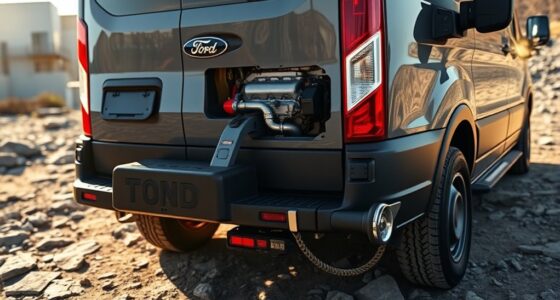Cargo tie-down rings are typically placed along the sides, floors, or ceilings of trailers, trucks, and containers to help you secure loads effectively. Side-mounted rings prevent lateral shifts, while floor-mounted ones secure heavier items, and ceiling rings are useful for taller or complex loads. It’s important to choose rings with the proper load ratings to guarantee safety. If you want to find out more about ideal placement and ratings, you’ll discover helpful tips ahead.
Key Takeaways
- Cargo tie-down rings are typically installed along trailer sides, floors, or ceilings for effective load securing.
- Proper placement ensures even weight distribution and reduces cargo shifting during transit.
- Load ratings indicate the maximum force rings can withstand; choose rated rings appropriate for cargo weight.
- Installation should follow manufacturer guidelines to ensure safety and prevent ring failure.
- Compliance with industry standards and regulations is essential for safe cargo securement and road safety.

Have you ever struggled to secure your cargo properly during transport? If so, you’re not alone. Ensuring your load stays in place is essential for safety and efficiency, and cargo tie-down rings play a critical role in this process. These rings act as anchor points, allowing you to attach straps, ropes, or chains securely to prevent shifting, sliding, or falling off during transit.
The key to effective cargo securing lies not just in having tie-down rings but in understanding their locations and ratings. Knowing where to place them and how strong they’re makes a significant difference in the safety of your load.
First, you should consider the typical locations for cargo tie-down rings. They’re usually installed along the sides, floors, or ceilings of trailers, trucks, and containers. Proper placement ensures even weight distribution and maximizes securing options.
For example, side-mounted rings enable you to anchor straps at various points along the length of your cargo, preventing lateral movement. Floor-mounted rings are essential for securing heavier items or pallets, offering a stable point directly beneath your load. Ceiling or roof-mounted rings, often found in enclosed trailers or cargo vans, provide additional tie points for securing taller or more complex loads.
The strategic placement of these rings allows you to create a web of securement points, reducing the risk of cargo shifting during sudden stops or turns. Additionally, proper installation techniques help ensure the rings perform their intended function safely and reliably.
However, just knowing where the rings are located isn’t enough; understanding their ratings is equally important. Cargo tie-down rings are rated based on the maximum load they can withstand, usually expressed in pounds or kilonewtons.
This rating indicates how much force the ring can handle without failing. To ensure safety, you need to select rings with ratings appropriate for your cargo’s weight and securing method.
For instance, if you’re transporting heavy machinery, you’ll require rings rated for several thousand pounds. Using rings with insufficient ratings compromises the security of your load and poses safety risks for you and others on the road.
Always check the manufacturer’s specifications and adhere to industry standards and regulations, which often specify minimum ratings for different types of cargo.
Frequently Asked Questions
Are Cargo Tie-Down Rings Weather-Resistant?
Yes, cargo tie-down rings are typically weather-resistant, designed to withstand outdoor conditions like rain, snow, and UV exposure.
You should look for rings made from corrosion-resistant materials such as stainless steel or coated metals, which help prevent rust and deterioration.
Properly maintained, these rings will last longer and keep your cargo secure in various weather conditions.
Always check the product specifications to verify they meet your weather resistance needs.
Can I Install Cargo Rings Myself?
Installing cargo rings yourself is totally doable with the right tools and a bit of patience. You can confidently do it without professional help, saving you a fortune and making you feel like a DIY hero.
Just make sure you pick the correct location, drill carefully, and secure the rings tightly. Follow instructions closely, and you’ll have sturdy cargo rings ready to handle even the heaviest loads in no time.
What Is the Maximum Weight Capacity for Cargo Rings?
The maximum weight capacity for cargo rings varies depending on their material and design, but typically ranges from 500 to 2,000 pounds.
Always check the specific rating marked on the rings or in the manufacturer’s instructions.
To guarantee safety, don’t exceed these limits, and regularly inspect the rings for wear or damage.
Properly rated cargo rings help secure your load safely during transport.
Are Cargo Rings Compatible With All Tie-Down Straps?
Not all tie-down straps are compatible with cargo rings. You need to check the strap’s hooks or ends to guarantee they fit the rings.
Some straps have hooks, carabiners, or loops designed specifically for cargo rings, while others may not connect securely.
Always verify the strap’s compatibility and weight capacity before use to ensure safe, effective securing of your cargo.
How Do I Maintain or Clean Cargo Tie-Down Rings?
Think of your cargo tie-down rings as the backbone of a sturdy bridge, holding everything steady. To keep them in top shape, regularly wipe away dirt and debris with a damp cloth.
For stubborn grime, use a mild soap solution. Rinse thoroughly and dry completely to prevent rust.
Occasionally, apply a light coat of rust inhibitor or lubricant to keep the rings moving smoothly, ensuring your cargo stays secure mile after mile.
Conclusion
Think of cargo tie-down rings as the anchors that keep your load steady on a rough sea. When I once secured a kayak with the right rings, it stayed perfectly in place through bumpy roads, preventing a costly spill. Just like a sturdy anchor keeps a boat from drifting, choosing the right location and rating guarantees your cargo remains safe, no matter the journey. Trust these rings—they’re your vehicle’s reliable lifeline.









